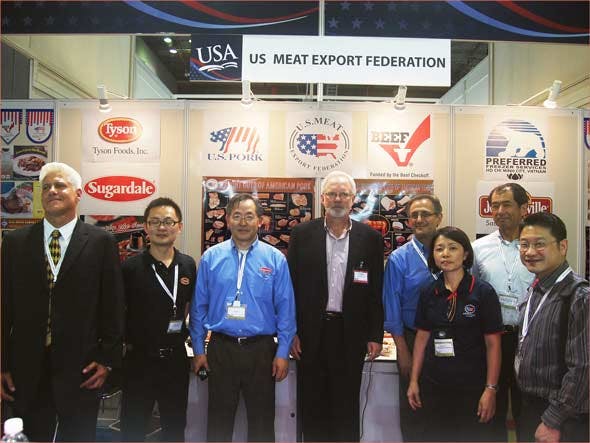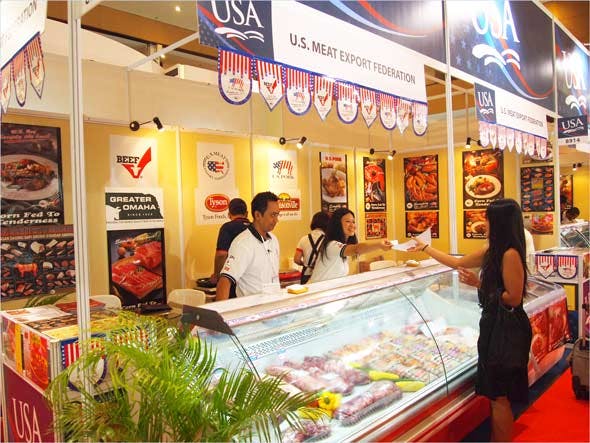U.S. Beef, Pork Showcased at Major ASEAN Food Shows
Published: May 17, 2013
USMEF recently participated in two of the ASEAN region’s largest food trade shows – Food & Hotel Vietnam and Food & Hotel Indonesia. Funding support for these events was provided by the USDA Market Access Program (MAP), the Pork Checkoff and the Beef Checkoff Program.

U.S. Ambassador to Vietnam David Shear (fourth from left) visits the USMEF booth at Food & Hotel Vietnam 2013
Held every two years, Food & Hotel Vietnam is in its seventh edition. This year, it drew about 12,000 food industry professionals over three days to the Saigon Exhibition & Convention Center in Ho Chi Minh City, with more than 400 exhibitors from 35 different countries. There was an especially strong turnout of U.S. exhibitors as the USA Pavilion doubled in size compared to 2011.
USMEF sponsored the U.S. Beef Culinary Challenge, which pitted 14 young chefs from leading hotels and restaurants in Vietnam in a competition to produce the best dish featuring U.S. striploin – a cut selected for the quality and versatility it delivers at an affordable price.
“The competition provided an excellent platform for U.S. beef to be featured in an array of creative dishes,” said USMEF-ASEAN director Sabrina Yin. “It was also a great opportunity for participating chefs to gain hands-on experience with U.S. beef and provided excellent exposure for U.S. striploin in a world-class cooking competition.”
Top honors in the U.S. Beef Culinary Challenge went to Le Nguyen Minh Tan of the Equatorial Hotel. As winner of the competition, he has been invited to participate in the next USMEF culinary training session in Singapore.
In addition to the main exhibition, USDA-FAS organized a U.S. Food Showcase and Reception at Riverside Palace. USMEF had a tabletop exhibit with extensive information on U.S. beef and pork, and guests were treated to a buffet consisting of several U.S. beef and pork dishes.

Attendees gather information on U.S. beef and pork at Food & Hotel Indonesia
Vietnam is traditionally the largest destination in the ASEAN region for U.S. beef, but lower exports in the first quarter of 2013 moved it to No. 2 behind the Philippines. It is the third-largest market in the region for U.S. pork, behind the Philippines and Singapore.The 12th edition of Food & Hotel Indonesia (also held biennially) was the largest ever, attracting more than 24,000 visitors from Indonesia and neighboring countries including Singapore, Malaysia, Philippines and Australia to the International Expo Kemayoran in Jakarta. More than 1,400 exhibitors from 45 countries participated, with exhibition space soaring 60 percent higher than the 2011 show.
Once a rapidly growing destination for U.S. beef, exports to Indonesia have been hampered recently by restrictive quotas aimed at bolstering domestic production. As a result of these policies, beef exports to Indonesia in 2012 suffered a year-over-year decline of more than 90 percent in volume and 70 percent in value.
“With exports to Indonesia impacted so dramatically in recent months, this event was an excellent opportunity to discuss market access issues with the local trade and gain insights into how they affect their businesses,” said Yin. “Not surprisingly, the drastic spike in food prices resulting from these policies has made for a very difficult business climate for Indonesia’s food industry.”
Pork is not widely consumed in Indonesia due to its predominantly Muslim population. But with a large number of expatriates and a growing need for affordable proteins to accommodate Indonesia’s booming tourism industry, interest in imported pork is on the rise. USMEF provided samples of boneless pork belly, boneless center-cut loin, back ribs and Johnsonville sausages at Food & Hotel Indonesia, all of which proved very popular with attendees.
“Response to our pork samples was extremely enthusiastic, with many visitors commenting that the flavor far surpasses that of local pork products,” Yin explained. “Pork is still a sensitive issue in Indonesia and our marketing efforts here must remain tactful. But attitudes toward pork are definitely changing and many of the new restaurants are anxious to include pork items on their menus.”
Though Indonesia is still a small destination for U.S. pork, exports through March nearly doubled in value (to about $316,000) compared to last year’s pace.
